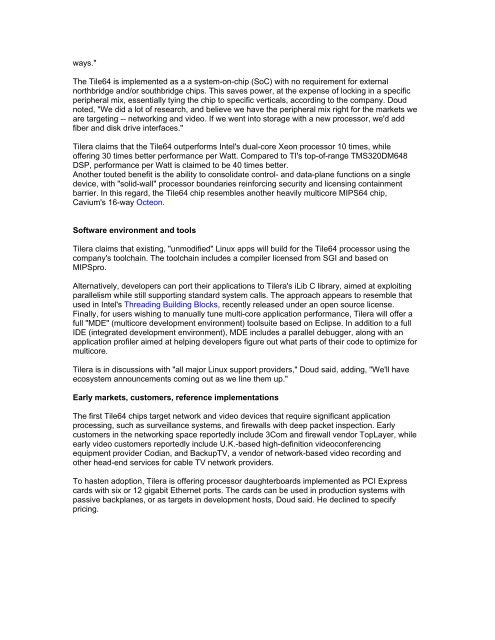64 Core Processors - MM4M
64 Core Processors - MM4M
64 Core Processors - MM4M
You also want an ePaper? Increase the reach of your titles
YUMPU automatically turns print PDFs into web optimized ePapers that Google loves.
ways."<br />
The Tile<strong>64</strong> is implemented as a a system-on-chip (SoC) with no requirement for external<br />
northbridge and/or southbridge chips. This saves power, at the expense of locking in a specific<br />
peripheral mix, essentially tying the chip to specific verticals, according to the company. Doud<br />
noted, "We did a lot of research, and believe we have the peripheral mix right for the markets we<br />
are targeting -- networking and video. If we went into storage with a new processor, we'd add<br />
fiber and disk drive interfaces."<br />
Tilera claims that the Tile<strong>64</strong> outperforms Intel's dual-core Xeon processor 10 times, while<br />
offering 30 times better performance per Watt. Compared to TI's top-of-range TMS320DM<strong>64</strong>8<br />
DSP, performance per Watt is claimed to be 40 times better.<br />
Another touted benefit is the ability to consolidate control- and data-plane functions on a single<br />
device, with "solid-wall" processor boundaries reinforcing security and licensing containment<br />
barrier. In this regard, the Tile<strong>64</strong> chip resembles another heavily multicore MIPS<strong>64</strong> chip,<br />
Cavium's 16-way Octeon.<br />
Software environment and tools<br />
Tilera claims that existing, "unmodified" Linux apps will build for the Tile<strong>64</strong> processor using the<br />
company's toolchain. The toolchain includes a compiler licensed from SGI and based on<br />
MIPSpro.<br />
Alternatively, developers can port their applications to Tilera's iLib C library, aimed at exploiting<br />
parallelism while still supporting standard system calls. The approach appears to resemble that<br />
used in Intel's Threading Building Blocks, recently released under an open source license.<br />
Finally, for users wishing to manually tune multi-core application performance, Tilera will offer a<br />
full "MDE" (multicore development environment) toolsuite based on Eclipse. In addition to a full<br />
IDE (integrated development environment), MDE includes a parallel debugger, along with an<br />
application profiler aimed at helping developers figure out what parts of their code to optimize for<br />
multicore.<br />
Tilera is in discussions with "all major Linux support providers," Doud said, adding, "We'll have<br />
ecosystem announcements coming out as we line them up."<br />
Early markets, customers, reference implementations<br />
The first Tile<strong>64</strong> chips target network and video devices that require significant application<br />
processing, such as surveillance systems, and firewalls with deep packet inspection. Early<br />
customers in the networking space reportedly include 3Com and firewall vendor TopLayer, while<br />
early video customers reportedly include U.K.-based high-definition videoconferencing<br />
equipment provider Codian, and BackupTV, a vendor of network-based video recording and<br />
other head-end services for cable TV network providers.<br />
To hasten adoption, Tilera is offering processor daughterboards implemented as PCI Express<br />
cards with six or 12 gigabit Ethernet ports. The cards can be used in production systems with<br />
passive backplanes, or as targets in development hosts, Doud said. He declined to specify<br />
pricing.


